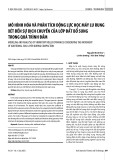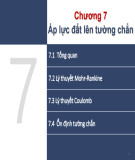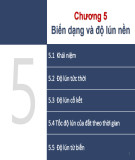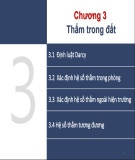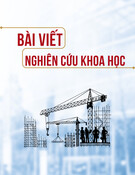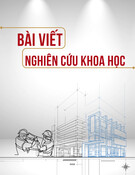
Journal of Mining and Earth Sciences Vol. 66, Issue 1 (2025) 9 - 20 9
Research on the application of dynamic cone
penetration test in evaluating the effectiveness of soft
soil treatment in some areas of Hai Duong province,
Vietnam
Phong Van Nguyen 1,2,*
1 Hanoi University of Mining and Geology, Hanoi, Vietnam
2 Research group of Engineering and Geoenvironment (EEG), Hanoi University of Mining and Geology, Hanoi,
Vietnam
ARTICLE INFO
ABSTRACT
Article history:
Received 05th Sept. 2024
Revised 08th Dec. 2024
Accepted 23rd Dec. 2024
In soft soil treatment, assessing the quality of on-site treatment is very
important. Common field testing methods used in Vietnam include Cone
Penetration Testing (CPT), Standard Penetration Testing (SPT), and Field
Vane Testing (FVT). Dynamic cone penetration testing (DCP) testing is a
simple and portable field method that allows for the assessment of soil
homogeneity, density, or state and the determination of some physical and
mechanical properties of the soil. This paper analyzes and systematizes
the content, subjects, and requirements for evaluating the quality of soft
ground treatment. It also assesses the applicability of the Dynamic cone
penetration testing and presents some experimental results from Hai
Duong province. The results show that the DCP test can evaluate
homogeneity and point out unsatisfactory sections in soil-cement piles.
For soft ground treated by cement - fly ash - marine sand piles (CFMS),
Dynamic cone penetration testing on three groups of the piles with
different binder contents (CKD = 5%, 10%, 15%) shows that the dynamic
cone resistance (qd) increases with the binder content. Using DCP testing
on the ground at three stages of construction, immediately after
construction, and 10 days post-construction allowed for the
determination of the effectiveness of each mechanical compaction and
consolidation process for each type of soil.
Copyright © 2025 Hanoi University of Mining and Geology. All rights reserved.
Keywords:
Dynamic cone penetration test,
Quality assessment,
Soft ground,
Soil-cement piles.
_____________________
*Corresponding author
E - mail: nguyenvanphong@humg.edu.vn
DOI: 10.46326/JMES.2025.66(1).02






